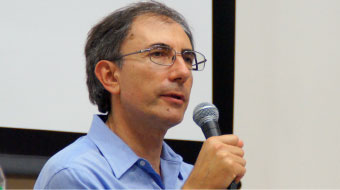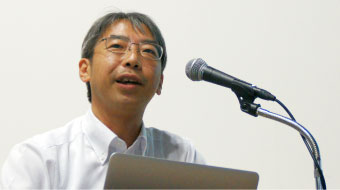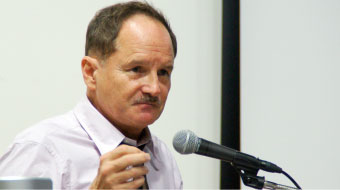
Inspiring Lecture Series kicks off
To introduce some of the exciting research that is taking place at Tokyo Tech, the Institute is holding a series of lectures, the "Tokyo Tech Inspiring Lecture Series." The first event of this series was held at Kuramae Hall, Tokyo Tech Front, at the Ookayama Campus on July 16, 2014.
The title of the event was "Origins: Earth and Life" and four world-renowned scientists connected to Tokyo Tech's Earth-Life Science Institute (ELSI) spoke about their research on the origin and evolution of the Earth and life.
ELSI researchers speak in the first event of the series
ELSI was launched as a research institution in December 2012 after being selected by the Ministry of Education, Culture, Sports, Science and Technology in October 2012 as part of the Ministry's World Premier International Research Center Initiative (WPI). ELSI's goal is to investigate how the Earth was created and formed. It also seeks to clarify the processes by which initial life emerged and how evolution occurred in the early Earth environment.
Researchers from Tokyo Tech and around the world in earth and planetary science and life sciences have come together at ELSI to conduct research toward this common goal. In addition, a new interdisciplinary field called bioplanetology has been created as part of ELSI's plan to become an international research hub. ELSI's new research building at the Ookayama Campus is scheduled for completion in the spring of 2015.
Closing in on the mystery of life's origins through artificial cells
 Jack W. Szostak
Professor of Genetics at Harvard Medical School and Principal Investigator at ELSI
Jack W. Szostak
Professor of Genetics at Harvard Medical School and Principal Investigator at ELSI
Recipient of the 2009 Nobel Prize in Physiology or Medicine along with Professor Elizabeth Blackburn of University of California, San Francisco, and Professor Carol Greider of Johns Hopkins University School of Medicine
The first speaker to take the floor was Professor Jack W. Szostak. His research area is molecular biology. In 2009, he was awarded the Nobel Prize in Physiology or Medicine for his research on telomeres and an enzyme called telomerase, which produces telomeres. Telomeres are found at the tips of chromosomes and play a role in cellular aging and cancer. Professor Szostak has since shifted his research focus to the origin of life. In this area, he has been working on the production of artificial cells for many years, and in his lecture, he introduced the latest research results that were obtained through his study of artificial cells.
The origin of cellular life

It is thought that approximately four billion years ago, molecules produced by chemical reactions were gradually altered under a certain environment and resulted in life. By reproducing the early Earth environment and creating artificial cells using chemicals that are likely to have existed at that time, Professor Szostak seeks to unveil the mechanisms responsible for the emergence and evolution of the protocells that became the origin of life on the Earth.
As a result of current experiments, he has learned that under the early Earth environment, clay minerals formed by volcanic ash that accumulated thickly in shallow seas could have become a catalyst that enabled ribonucleic acid (RNA) to be assembled. Furthermore, this could have promoted the formation of fatty sacks called membrane vesicles, and brought RNA together inside the vesicles.
"The fluctuations in the environment can drive growth and division without any complicated evolved biological machinery. We think that this could have set the stage for the emergence of Darwinian evolution where only the RNA that contained useful genetic information could survive. That's exactly what we want to reproduce and see in the laboratory."
Beginning the search for extraterrestrial life within 5 to 10 years
 Dimitar Sasselov
Director, Origins of Life Initiative, Harvard University
Dimitar Sasselov
Director, Origins of Life Initiative, Harvard University
(ELSI's satellite center)
The second speaker of the event was Professor Dimitar Sasselov, whose specialization is astronomy. He believes it is vital to find life on other planets in order to illuminate the origin of life on the Earth, and has been searching for planets beyond the solar system. In his lecture, Professor Sasselov introduced the conditions under which life might exist on planets outside the solar system, and the methodologies used in the search for extraterrestrial life.
Other Earth and the search for life beyond the solar system
Professor Sasselov started out by introducing the Kepler space telescope launched by NASA in 2009. NASA launched the telescope in order to better understand the extent to which fixed star and planetary systems might exist outside the solar system and to observe how many of these planets might be able to support life. This is called the Kepler Mission.
As a result of analyzing the images taken by this telescope over a period of about four years, we learned that several hundred million exoplanets exist in the Milky Way alone, including many where life is suspected to exist. Professor Sasselov was deeply involved in the Kepler Mission and introduced some of the latest results of the mission, including findings regarding the Kepler-62 planetary system. This planetary system has two orbiting planets within its habitable zone (a region where life can exist).
Professor Sasselov also introduced the remote sensing technology employed as a method to confirm whether life exists on exoplanets. Remote sensing is a technology to capture, by observing the spectrum of light that is reflected by or penetrates the atmosphere of a planet, the small quantities of gases that life generates. The exploration for life through the use of remote sensing technology will be pursued using the Transiting Exoplanet Survey Satellite NASA currently plans to launch in 2017, and the James Webb Space Telescope scheduled for launch in 2018.
"This search for life beyond the solar system is going to happen in the next 5 to 10 years. We are all very lucky to live in this time because for the first time in human history, we actually have the ability to at least try to answer the ultimate question."
Large quantities of water penetrated the Earth's interior
and contributed to the development and diversity of life
 Kei Hirose
Director of ELSI
Kei Hirose
Director of ELSI
Recipient of the 2008 Japan Society for the Promotion of
Science Award, 2011 Japan Academy Prize, and 2011 Science Innovation Award - Ringwood Medal from the European Association of Geochemistry
The third speaker of the event was Professor Kei Hirose. His area of research is geophysics. The Earth's interior is understood to be divided into several layers. Starting from its center, the Earth is
sequentially comprised of the core, the mantle and the crust. In his experiments, Professor Hirose analyzes the changes in the chemical structure of a sample by placing it between two diamonds and applying high pressure and high temperature to replicate the
Earth's interior.
Origin of water on the Earth
Through his latest research, Professor Hirose discovered that the Earth's core contains a substantial quantity of hydrogen. This finding shows how the early Earth might have supported the development of life and evolution.
Professor Hirose introduced the idea that water was supplied to the Earth when large quantities of planetesimals containing water were scattered by the gravity of Jupiter, which was born around the same time the Earth was formed. He and his collaborators theorize that the substantial quantity of hydrogen in the Earth's core is evidence that up to 80 times the volume of today's seawater existed when the Earth was first formed.
Then what became of such a large volume of water?
As one of the possibilities, he outlined a scenario in which the entire Earth was completely molten when the water was supplied due the impact of huge astronomical bodies. The majority of this water may have combined with magma and reacted with iron to form iron oxide that was subsequently carried into the Earth's core.
"A large amount of water was supplied to the Earth during the Earth's formation, but very fortunately, the Earth ended up with a shallow ocean because it stored most of the water in its deep interior. This resulted in the coexistence of land and ocean, allowing for diverse environments. This was critically important for the evolution of life and perhaps essential for the development of life as well."
Our birthplace is the Tharsis volcanic platform on Mars
 Joseph L. Kirschvink
Nico and Marilyn Van Wingen Professor of Geobiology,
Joseph L. Kirschvink
Nico and Marilyn Van Wingen Professor of Geobiology,
California Institute of Technology, and Principal Investigator at ELSI Commended by the Japan Geoscience Union as a Fellow in 2014
Recipient of the 2014 George P. Woollard Award from the Geological Society of America
The last speaker of the event was Professor Joseph L. Kirschvink, whose research area is geobiology. He compared the environments of Mars and Earth at the time they were formed, and discussed which of the two planets was more suitable for the development of life.
Mars vs. Earth - planetary constraints on the origins of life
Development of life requires ribose, which is a fundamental component of RNA, but it was said that ribose is difficult to produce without biological process. In 2004, however, it was shown that ribose is formed when a mineral substance that can be made from calcium and borate acts as a catalyst, and furthermore, it was shown that this mineral substance is formed under a desert-like environment.
Based on the results of Mars exploration, such an environment is believed to have existed on Mars. The Tharsis volcanic platform is estimated to have formed about four billion years ago, a period when Mars may had an ozone layer, ocean and land. This volcanic platform is surmised to have been an environment offering excellent circumstances for the birth of life. Professor Kirschvink introduced a theory that life emerged in the Tharsis volcanic platform on Mars and was transported to Earth by meteorites.
However, many researchers believe that even if life was transported by meteorites, it would almost surely have been killed by frictional heat by the time it reached the Earth. In response to this theory, Professor Kirschvink used devices such as the superconducting quantum interference device to show that the heat effects do not extend to the interior of meteorites.
"Because ribose synthesis could occur more easily on early Mars than on Earth, and it is feasible that living organisms such as bacteria were transported from Mars to Earth by meteorites, I believe our ancestors were born in the Tharsis volcanic platform on Mars."
Interview with Professor Jack W. Szostak
To know the origin of life, we must know the origin and history of the Earth

Professor Szostak, could you begin by telling us the reasons you accepted the position of Principal Investigator at ELSI?
Unraveling how life on Earth began and the mysteries of evolution are humanity's most fundamental themes. To approach these mysteries, we have to understand the Earth's origin and history.
At ELSI, we have both earth scientists and planetary scientists who are researching the origin and history of the Earth, and life scientists who are researching the origin of life and the history of evolution. There are virtual institutes other than ELSI as well that have brought together earth and planetary science and life sciences researchers and are conducting research on similar themes. There are very few laboratories that provide an environment like ELSI, however, where researchers from different fields can mutually collaborate closely, in a really earnest way, and work as a team towards a single objective. For me, I find this to be the most appealing aspect of ELSI.
At the moment, we have one ELSI researcher who mainly works at the Harvard Medical School and travels between the United States and Japan a number of times throughout the year. In the future, I hope to make it possible for many more researchers to move between Harvard and Tokyo Tech.
Work on what you think is interesting
Professor Szostak, I heard that you are trying to approach the problem of the origin of life through the creation of artificial cells. Could you please tell us about your results, what you've learned and your current research topic?
A scenario for the generation, growth, division and proliferation of the protocells that became the origin of life on the Earth has emerged. In fact, in my laboratory, we are now able to reproduce the processes from the generation of protocells to their proliferation using artificial cells if appropriate materials and environment are available.
Numerous issues still need to be clarified, however. Of these, the one that I think is the most difficult is answering the question about the source of chemical energy.
We sustain our lives by taking food into our bodies, decomposing them by using enzymes and using the chemical energy generated as a result of the decomposition. Early life, on the other hand, did not have complex materials like enzymes. What we don't understand is how life back then was able to obtain chemical energy. This is an extremely perplexing problem, but at some point we will solve the puzzle, so please look forward to that.
Lastly, could you give a message to young people aspiring to become scientists?
I guess what I want to say to young scientists is that there are many interesting questions in all aspects of science. Work on what you think is interesting. Don't just follow the crowd. If there is no appropriate technique, you have to invent it. Do your best in making your dream come true.
The Special Topics component of the Tokyo Tech Website shines a spotlight on recent developments in research and education, achievements of its community members, and special events and news from the Institute.
Past features can be viewed in the Special Topics Gallery.
Published: September 2014
. Any information published on this site will be valid in relation to Science Tokyo.










